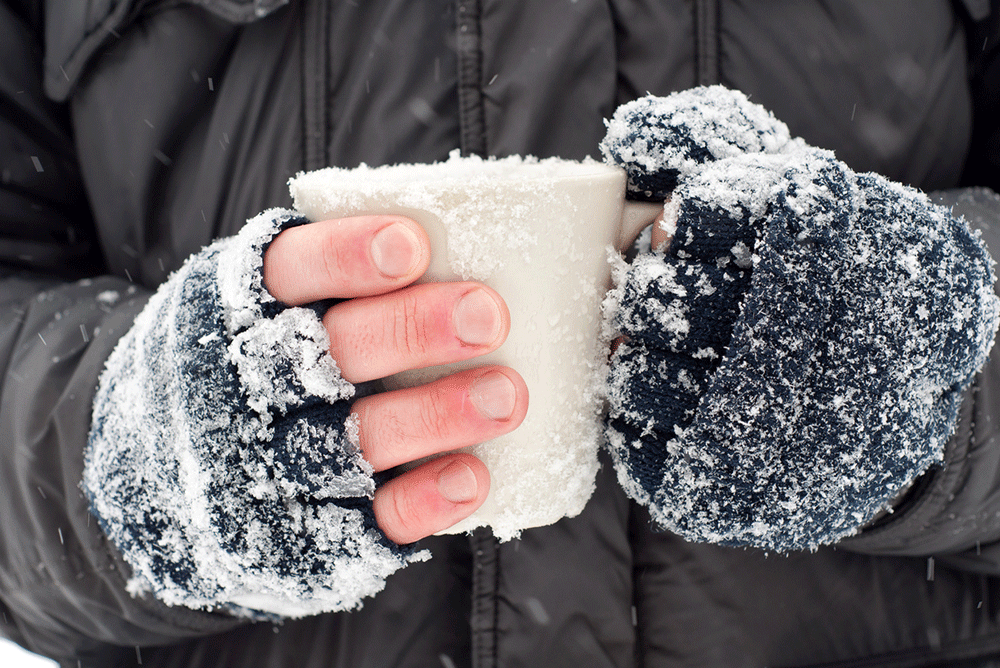
iStock
ALTHOUGH THE PLANET is warming with every passing year, temperatures around the DMV can fluctuate so wildly over a period of hours that it’s never safe to forget entirely about frostbite. Go for a walk or bike ride, and the trip home can become suddenly and worrisomely cold, windy and wet.
Loss of sensation in fingers, toes, ears and noses calls for taking correct measures and avoiding wrong ones. Among the latter: hot water, dry heat such as fire, rubbing and walking on affected toes.
Most important: If there’s any chance of refreezing in the immediate future, nothing at all should be done. Fluids within frostbitten tissue can form ice crystals, causing potentially permanent changes in the cells. Refreezing delicate frostbitten tissue creates greater risk of the worst outcomes, including gangrene and amputation.
Frostbite is more likely with exposure to below-freezing temperatures, especially with high winds and wet conditions, and with unsuitable clothing — either too tight or not protective against cold, windy or wet weather. To preserve body temperature, blood vessels close to the skin surface constrict, and blood is shunted away from the extremities.
Metal jewelry can speed cooling, and ears are among the most often frostbitten body parts. Besides weather, other causes of frostbite include touching ice, cold packs or frozen metal; and prolonged exposure to aerosol sprays, for example, causing deodorant burn.
Risk increases for both infants and older people; and with dehydration, exhaustion and medications like beta-blockers. And because of anything that limits blood flow to the extremities, including poor circulation — for medical reasons, or because clothes or boots are too tight — and peripheral neuropathy, alcohol and nicotine, heart disease and diabetes. Also: fear or panic, previous frostbite or cold injury, and high altitudes, which reduce oxygen supply to the skin.
In very cold weather, the body’s first reaction is “frostnip,” with skin turning pale or red — followed by red, white or yellow patches, itching, pain and prickling. Also, numbness that can prevent recognition of problems until someone else points them out. Superficial or second-degree frostbite comes next, causing the skin to turn paler, harden and begin to feel warm — the last is an especially bad sign. Warming the area at this point may cause stinging, burning and swelling; skin appearing mottled, blue or purple; and blisters appearing within 36 hours.
Severe, third- and fourth-degree, deep frostbite causes the skin to feel hard and waxy with loss of all feeling of cold or discomfort, and large blisters that form in the first 48 hours. The blisters are purple but turn black, and are usually filled with blood. Pain, skin that remains red or pale, blisters and fever all indicate the need for medical attention.
(Chilblains, also called perniosis, is a different reaction to cold in predisposed individuals, in which capillaries close to the skin surface are damaged, causing redness, itching, inflammation and sometimes blisters.)
For any stage of frostbite, the best first response is to soak the affected body parts in water that is warm — not hot but comfortable to the touch — and leave them there for 30 minutes, which can be painful enough to require OTC painkillers. Seriously frostbitten extremities should be elevated and wrapped or splinted to prevent any ice crystals from moving around, which can cause further damage. Drinking hot liquids like tea or hot chocolate can help as can exercise to keep the blood flowing — but only if the condition is mild and with care to avoid exhaustion.
When stranded in a car, make sure the exhaust pipe is cleared of any snow or ice, the engine and heater can be run for ten minutes every hour, with one window slightly open to avoid carbon monoxide fumes.
The best prevention is loose-fitting layered clothing, with inner layers of wool, silk or polypropylene; and wind-resistant outer layers to avoid losing body heat in cold wind, according to the CDC. Also, despite their renowned unreliability, keeping track of weather reports is a good idea.
The best defense, of course, is the coming of spring. With the December 21 solstice finally past, the days are getting longer, and warm weather is around the corner — in three months or so.
— Mary Carpenter
Mary Carpenter is the well-being editor of MyLittleBird. Click here to see more posts.
